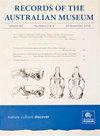Mysid subfamily Boreomysinae (Crustacea: Mysida: Mysidae) in the southeast Australian deep-sea
IF 0.8
4区 生物学
Q4 ZOOLOGY
引用次数: 0
Abstract
The deep-water mysid crustaceans of Australia have been barely known. Recent explorations of RV Investigator (CSIRO) in the southeast Australian waters discovered a unique fauna. In this special study of the marine subfamily Boreomysinae (family Mysidae) in Australia, five species from both genera Boreomysis and Neobirsteiniamysis are reported, including two new species for science: B. inopinata sp. nov., B. sibogae, B. sphaerops, B. urospina sp. nov. and N. inermis. Among the members of the subfamily, only B. sibogae has been previously known from Australia. The genus Neobirsteiniamysis and its bipolar-amphitropical species N. inermis are firstly recorded in Australia. Boreomysis inopinata sp. nov. has additional spinules on the outer spine of the antennal scale, which are not found in other species of the subfamily. Boreomysis urospina sp. nov. has the longest first segment of the uropodal exopod, laterally terminated by three spiniform setae; and its uropodal endopod is armed with up to five medial spiniform setae, the largest number in the subfamily. This species is included in a newly established subgenus Petryashovia subgen. nov., which unites epi-mesopelagic boreomysines, lacking the rostral projection, having rather small ventrolateral lobes of the carapace, and the 1-segmented propodus of the pereopods. The subfamily and generic diagnoses are updated. Additionally, a fragment of the mtDNA COI gene was sequenced for most of the studied species.澳大利亚东南部深海的Myside亚科(甲壳纲:Mysida:Myside)
澳大利亚的深水mysid甲壳类动物鲜为人知。RV调查员(CSIRO)最近在澳大利亚东南部水域的勘探发现了一种独特的动物群。在对澳大利亚海洋亚科Boreomysinae(Mysadae)的专题研究中,报道了Boreomysis属和Neobirsteiniamsis属的五个物种,其中包括两个科学新种:B.inopinata sp.nov.、B.sibogae、B.sphaerops、B.urospina sp.nov..和N.inermis。在该亚科的成员中,以前只知道来自澳大利亚的B.sibogae。在澳大利亚首次记录到新双壳虫属及其两极两栖种N.inermis。诺皮纳塔北方菌在触角鳞的外棘上有额外的小刺,这在该亚科的其他物种中没有发现。urospina sp.nov.具有最长的尾足外足第一节,由三个棘状刚毛横向终止;其尾足内足有多达五个内侧棘状刚毛,是亚科中数量最多的。本种包含在一个新建立的Petryashovia亚属中。nov.,它结合了表中上层北方动物,缺乏喙部突起,甲壳的腹外侧裂片相当小,多年生动物的前足为1节。更新亚家族和一般诊断。此外,对大多数研究物种的线粒体DNA COI基因片段进行了测序。
本文章由计算机程序翻译,如有差异,请以英文原文为准。
求助全文
约1分钟内获得全文
求助全文
来源期刊
CiteScore
0.90
自引率
0.00%
发文量
9
审稿时长
>12 weeks
期刊介绍:
Records of the Australian Museum, volume 62 was published in 2010, volume 63 in 2011. Monographic works of particular significance are published irregularly as Records of the Australian Museum, Supplements (ISSN 0812-7387).

 求助内容:
求助内容: 应助结果提醒方式:
应助结果提醒方式:


